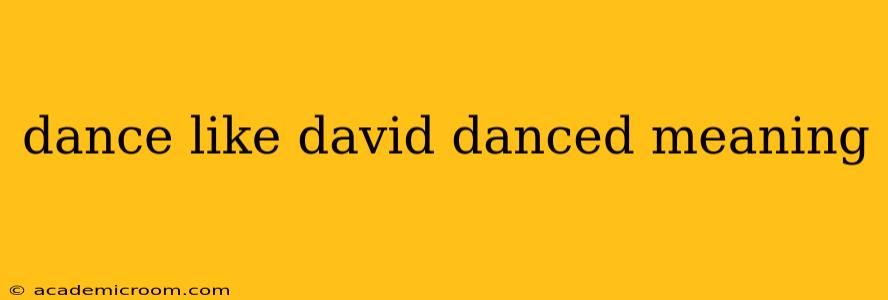The phrase "dance like David danced" isn't a common idiom with a single, universally accepted meaning. Instead, its interpretation depends heavily on context and the speaker's intention. However, its power lies in its evocative imagery, drawing on the biblical story of David and its symbolic resonance across cultures and time periods. This exploration will delve into various interpretations and the enduring significance of the phrase.
What is the Biblical Story of David Dancing?
The most prominent source of the imagery is the biblical account in 2 Samuel 6, where King David joyfully dances before the Ark of the Covenant as it's brought to Jerusalem. This act is described as exuberant and unrestrained, defying societal norms of regal decorum. David's dance is depicted as a passionate expression of faith, worship, and overwhelming joy.
What Does "Dance Like David Danced" Mean?
The meaning of "Dance Like David Danced" centers around embracing unrestrained joy and passionate expression. It encourages:
- Letting go of inhibitions: David's dance wasn't polished or refined; it was raw and spontaneous. The phrase suggests shedding self-consciousness and allowing authentic emotion to guide your movements.
- Unashamed worship and celebration: David's dance was a public display of his faith. "Dance like David danced" can imply celebrating something deeply meaningful with unrestrained enthusiasm.
- Embracing individuality: David, a king, chose to express himself in a way that defied expectations. The phrase encourages embracing one's unique style and self-expression.
- Finding joy in the moment: David's dance was a response to overwhelming joy and gratitude. "Dance like David danced" prompts a focus on present happiness and spontaneous celebration.
What are different interpretations of the phrase?
The phrase's meaning can be nuanced depending on context:
- Religious context: It could represent fervent worship and a passionate connection with God.
- Secular context: It might encourage abandoning social constraints and expressing oneself freely, regardless of external judgment.
- Artistic context: It could symbolize embracing raw emotion and uninhibited creativity in artistic expression.
Why is the phrase significant?
The power of "Dance like David danced" lies in its evocative imagery. It speaks to a primal, human urge to express joy and emotion through movement. It reminds us:
- To celebrate life's victories: The phrase offers a powerful metaphor for celebrating accomplishments and overcoming obstacles.
- To find joy amidst adversity: It speaks to the ability to find joy even in difficult circumstances, drawing strength from inner faith and resilience.
- To break free from societal norms: It inspires courage to challenge conventions and express oneself authentically.
What does it mean to dance without inhibition?
Dancing without inhibition means letting go of self-consciousness and fear of judgment. It's about allowing your body to move freely, expressing emotion authentically without worrying about how you look or what others think. It's a form of liberation, a connection to your inner self, and a celebration of life's joys.
How can I dance like David danced?
There's no specific choreography for "dancing like David danced." It's more about the spirit and feeling behind the movement. To embrace this idea:
- Find the source of your joy: Identify the emotion or event that inspires your dance.
- Let your body move freely: Allow your body to express that emotion naturally, without overthinking the steps.
- Embrace spontaneity: Don't plan the movements, let them flow from your inner feeling.
- Don't worry about perfection: Focus on expressing yourself, not on looking perfect.
In conclusion, "Dance like David danced" is not simply about physical movement. It's a call to embrace unrestrained joy, authentic self-expression, and a deep connection with one's inner self and/or faith. Its meaning is multifaceted and deeply personal, resonating with individuals across various backgrounds and beliefs.
